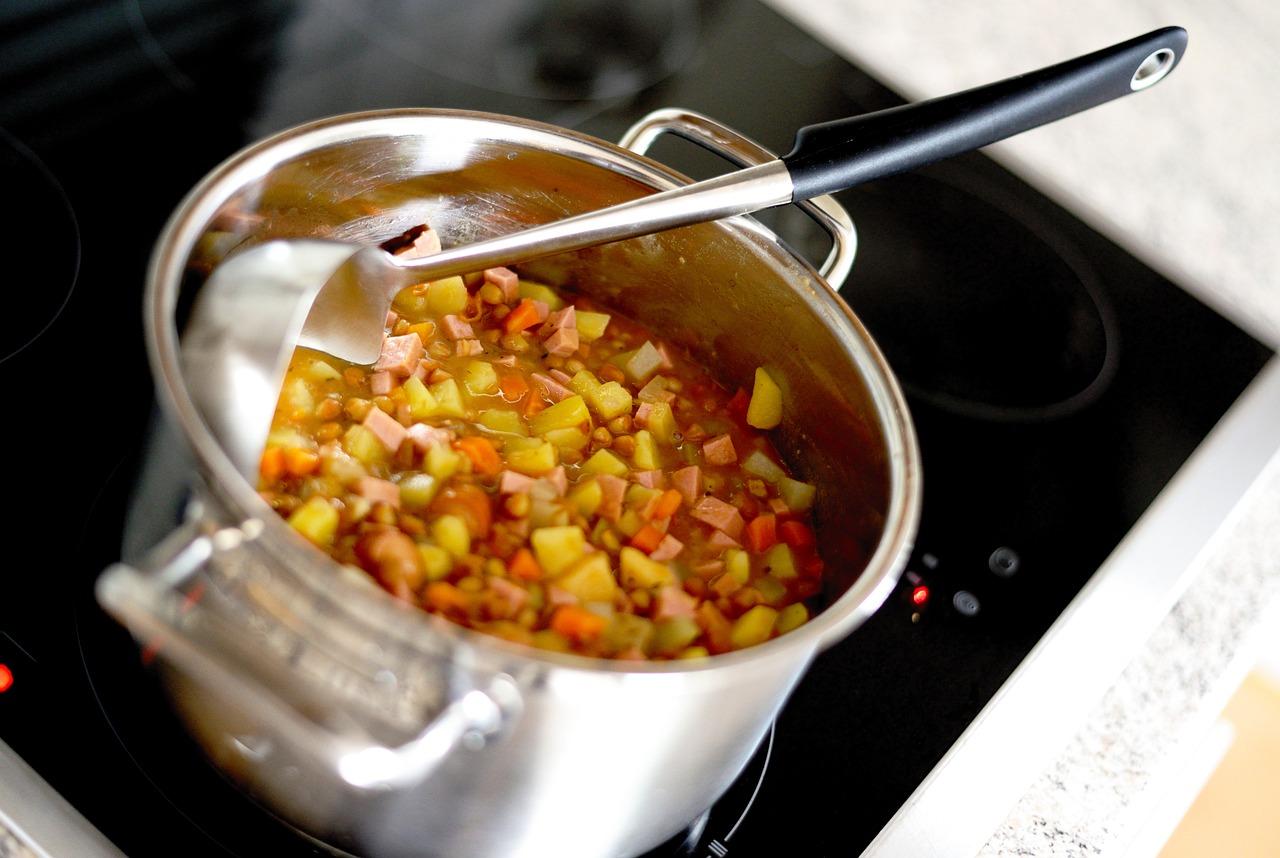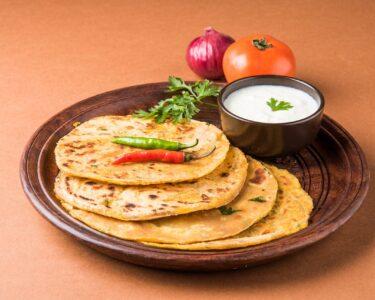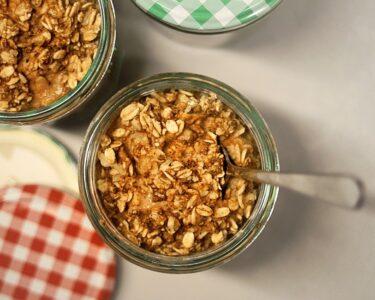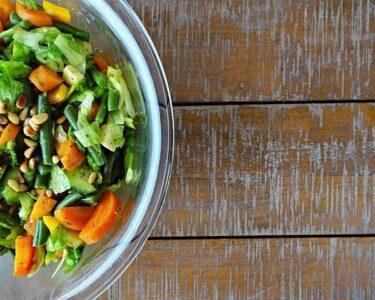Having a hectic workday? No time to cook an elaborate meal? But want to eat something healthy and tasty? Ordering food every day is certainly not a great option considering your health and budget. So, what to do? Relax. This blog is all about that.
Let’s figure out 3 basic one-pot meal structures with more than 25 variations for your Indian diet which are going to be –
- easy to cook
- need no fancy ingredients
- healthy
- tasty
- nutritionally well balanced
Why one pot meals getting popular?
The simple answer is lack of time. Gone are days when our parents or grandparents had ample time and energy to cook delicious elaborate meals every day.
A healthy one-pot meal is a combination of foods from different food groups which complement each other nutritionally to make it balanced.
The checklist for any good one-pot meal is that it has to be –
- Quick
- Healthy, nutritionally balanced
- Tasty
- Convenient to carry
- Need simple basic ingredients & equipment, no fancy stuffs
- Need no cooking expertise
- Customizable as per taste, available ingredients
Traditional Indian meal
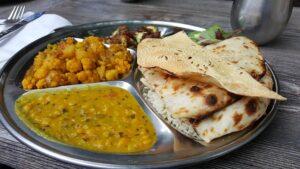
It is important to note that traditional Indian meals are nutritionally well balanced, a great combination of various textures, flavor and satisfy all most all tastes – sweet, sour, salty, bitter, etc. It has great regional variations as per the availability of the ingredients and climatic conditions. So whenever possible try to invest your time and energy to prepare a typical Indian meal.
A typical traditional Indian meal is consisting of –
| Items | Nutritional Significance |
| Rice/ Roti | Prime source of carbohydrate – essentially provides energy |
| Dal/Chole/Rajma/Chana/Sambar | Prime source of protein – mainly helps in body growth, repair, development etc |
| Sabji – Any cooked vegetables | Prime source of fiber, vitamins & minerals – helps in fighting against diseases |
| Salad – raw vegetables | Prime source of fiber, vitamins & minerals – helps in fighting against diseases |
| Fish/ chicken/ meat/ egg – Optional | Prime source of protein – mainly helps in body growth, repair, development etc |
| Curd/Buttermilk/Lassi/ Chaas | Prime source of protein & great for gut health |
The only struggle to follow this time-tested healthy and tasty structure is our lack of time. Often, we end up preparing only dal -chawal or roti–sabzi for a day, missing all the other items. Therefore, the one-pot meal comes as a savior in terms of balancing all the nutrients, taste, and time.
The Basic structure of a healthy one-pot meal
A healthy one-pot meal must follow a basic structure to pick ingredients that make nutritionally balanced.
Here is the basic structure –
| Nutrients | Ingredient options number | r of ingredients to add as per choice |
| Carbohydrate | Rice/ Dalia or Broken Wheat/ Suji/ Buckwheat/ Corn/ Sabudana/ Steel cut Oats/ Quinoa/ Jowar/Bajra/ other millet | Any one only |
| Protein | Sprouts/Dal/ Chana/ Chole/ Rajma/ Soybean/egg/ Chicken/Fish/ Meat/ Paneer | At least 1-2 |
| Fat | Ghee/ Butter/ Oil/Nuts & seeds | At least 1 |
| Vitamins & minerals | Seasonal & local vegetables – leafy and/or roots tubers and/or others / Fruits – sweet or neutral or citrus | At least 3 |
3 Ideas for an easy one-pot meal with more than 25 variations
Idea 1: Desi khichri – One Pot Meal
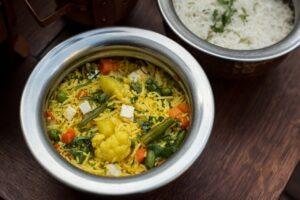
No matter how much you make face, khichri is one of the best comfort foods for many. It is time tested easy to cook, a healthy & tasty one-pot meal.
If you are not a traditional khichri fan, you may try its other healthy variations. Follow the table below to pick your ingredient –
| Nutrient | Possible choice of ingredients | Number of ingredients to add |
| Carbohydrate | Choice of grain –
Rice/ Dalia/Buckwheat/ Jowar/Bajra/ Quinoa/ Steel cut oats |
Only one |
| Protein | Choice of dal –
Moong dal/ Masoor dal/ Tuer dal etc |
One or two |
| Choice of non-veg –
Egg / Meat |
Optional – any one | |
| Fat | Oil/ Ghee | One or two |
| Vitamins & Minerals | Any locally available vegetables | at least three |
Possible variation –
There are at least 7 types of khichri you can make as per your choice and available ingredients. Each khichri tastes different with changes of grain and dal in it.
- Normal Khichri
- Dalia Khichri
- Buckwheat khichri
- Jowar Khichri
- Bajra Khichri
- Steel-cut oats khichri
- Quinoa khichri
Basic cooking process –
- Soak the grain for a few hours depending on the nature of the grain for better digestion and fast cooking, eg –
- Dalia needs no soaking
- Steel-cut oats/ Buckwheat/ Rice for approx. 1 hr
- Quinoa for approx. 2 hrs
- Jowar/ Bajra for approx. 8 hrs
- If you are using moong dal then consider roasting it for a few minutes before cooking
- If using any other dal then soak it for 1-3 hrs for faster cooking and better digestion
- Heat the oil.
- Add spices – red chili, bay leaf, ginger, jeera, green chili in hot oil. You may add onion, garlic, or hing as per your choice. Cook for 2 minutes.
- Add the soaked and strained grain and dal to it.
- Add chopped vegetables – carrot, beans, peas, cauliflower, tomato, pumpkin, spinach, bottle gourd etc as per your choice.
- Mix it well and add turmeric, salt, cumin powder, coriander powder, etc as per your choice.
- Mix it well for a few minutes.
- Add ample water and cover the pot with a lid.
- Allow it to cook for 25 minutes.
- Check in between and stir it.
- Adjust the flame/ power as per need.
- Once fully cooked, serve hot.
Pro Tips –
- Take grain: dal in a 1:1 ratio. This helps to improve the amino acid profile of the final food by complementing each other.
- Use good quality oil/ ghee but use it in limit.
- Add loads of veggies.
- Have curd or omelet or fried fish as a side dish to boost your protein intake
- Avoid dalia khichri if you are gluten sensitive
- Seasons best for having khichri – monsoon, winter, spring
Idea 2: Hearty Stew – One Pot Meal
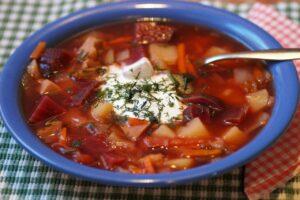
Stew is underrated. Many of us think stew is only for sick people. It is not. The best part is that you can always tweak the nutrient content of the stew by altering ingredients. It is filling, you can adjust the taste as per your choice, and a great option for dinner.
Follow this table to pick your ingredient –
| Nutrient | Possible choice of ingredients | Number of ingredients to add |
| Carbohydrate | Choice of grain –
Rice/ Dalia/ Buckwheat/ Corn/ Oats /Quinoa/ Pasta/ Noodles/ Bread |
Only one |
| Protein | Vegetarian options –
Any dal (Masoor/moong/tuer etc) or, Any beans (Rajma/ chole/ chana/lobia/soybean) or, Any sprouts (green moong/ chana etc) Paneer /Tofu |
One or two – |
| Non-vegetarian options –
Egg/Chicken/ fish fillet |
Optional – any one | |
| Fat | Oil/ Ghee/ Butter | One or two |
| Vitamins & Minerals | Any locally available vegetables | At least 3-4 |
Possible variation –
There are at least 11 types of stew you can make as per your choice and available ingredients. Each stew tastes different with changes of grain and dal in it. Tastes and texture of the stew vary with the addition of paneer, chicken, tofu, egg, etc.
- Rice Stew
- Dalia Stew
- Buckwheat Stew
- Oats Stew
- Quinoa Stew
- Corn Stew
- Stewy noodle
- Stewy Pasta
- Vegetable Stew with Toast
- Chicken-Veg Stew with Toast
- Mutton-Veg Stew with Toast
Basic cooking process –
- Soak the grain for a few hours depending on the nature of the grain for better digestion and fast cooking, eg –
- Dalia/ Rolled Oats/Corn needs no soaking
- Noodle/ Pasta for 5- 10 mins in hot water
- Steel-cut oats/Buckwheat/ Rice for approx. 1 hr
- Quinoa for approx. 2 hrs
- Soak dal for 1-3 hrs and beans for 8 hrs for faster cooking and better digestion
- Heat 1-2 teaspoons of butter/ghee in a pressure cooker.
- Add the soaked grain, soaked dal/beans/sprouts, and chopped veggies in it.
- Add salt, and ginger garlic paste to it.
- Mix it well and cook for 2-3 mins
- Add water and pressure cook the food for 2 whistles
- Turn off the stove
- Wait for 10 minutes and open the lid
- Add 1 teaspoon of butter on top
- Serve hot
- If planning to have stewy noodles/pasta, add soaked pasta/noodles at the end of the stew from the top.
Pro Tips –
- If trying to lose weight or struggling with diabetes use only a handful of grain of your choice and use 2 handfuls of dal/beans/sprouts
- Use 1-2 tsp of good quality oil/ ghee/ butter
- Add loads of veggies.
- Dal helps to give a thick texture to the stew
- You can also use coconut milk for a sweet creamy texture
- You can add chili oil/ chili flakes/herbs/ lemon/ pepper etc from the top as per your choice
- You can add chicken pieces/ paneer/tofu in the stew or, can have egg/ fish fillet as a side dish to boost the protein intake
- Avoid dalia, pasta, and noodles if you are gluten sensitive
- Seasons best for having stew– monsoon, winter, spring.
Idea 3: Hearty Salad – One Pot Meal
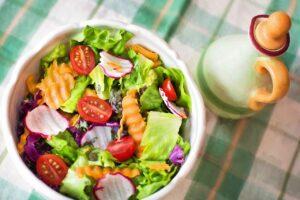
Salad is not boring if you are using the right salad dressing. It is a fantastic choice if you are trying hard to lose weight or to control blood sugar/cholesterol, cure fatty liver, PCOD, etc.
Follow this table to pick your ingredient –
| Nutrient | Possible choice of ingredients | Number of ingredients to add |
| Carbohydrate | Choice of grain –
Dalia/ Buckwheat/ Corn/ Steel cut oats /Quinoa |
Only one – Just a handful -optional |
| Protein | Vegetarian options –
Any beans (Rajma/ chole/ chana/lobia/soybean) Any sprouts (green moong/ chana etc) Paneer /Tofu |
One or two – |
| Non-vegetarian options –
Chicken |
Optional | |
| Fat | Oil, Nuts – walnut, almond, cashew, peanut, Seeds – pumpkin seed, sesame seeds, flaxseed | 2-3 |
| Vitamins & Minerals | Any locally available vegetables | At least 3-4 |
Possible variation –
There are at least 5 types of basic salad you can make as per your choice and available ingredients. Each salad tastes different with changes in its protein source and salad dressing.
- Basic vegetable sprout salad
- Basic chicken salad
- Basic panner salad
- Basic tofu salad
- Basic soybean salad
- Basic Rajma salad
- Basic Chole salad
Here are 16 simple & healthy salad dressing Ideas for the Indian diet.
Basic salad-making process –
- Chop the vegetables of your choice – carrot, beetroot, cucumber, onion, tomato, peas, lettuce, cabbage, capsicum, radish, etc
- You can also add fruits like apples/pomegranates/ raw mango/ pear etc
- You can lightly toss a few veggies like onion, capsicum, cabbage, carrot, beetroot, etc, or keep it raw as per your taste.
- Take the proteins like chicken/paneer/tofu/sprouts/beans/soybean etc for boil/toss/steam as per your choice
- Let it cool down
- Mix the veggies/ fruits/proteins in a salad bowl
- Add salad dressing to it and mix with a light hand.
- Sprinkle roasted or soaked nuts and seeds on top
- You can add a handful of one grain – quinoa/corn/steel cut oats/dalia etc as per your choice to make the salad more filling
Pro Tips –
- If trying to lose weight or struggling with diabetes use hearty salad is a great meal option.
- Try a variety of salad dressings to make it interesting.
- Add loads of veggies.
- Don’t forget to add healthy fat like nuts and seeds on top.
- Always use roasted or soaked nuts &seeds for better nutrient absorption.
- Avoid raw vegetable salad during monsoon.
- Seasons best for having a salad– summer, winter, spring.
Bottomline
Instead of eating junk, ordering food from a restaurant, and investing 20-30 mins to prepare a one-pot meal is a smart move for anyone. You will save a lot of money and health. Try these 3 basic one-pot meal ideas with 25 variations. I am sure you will love it.

